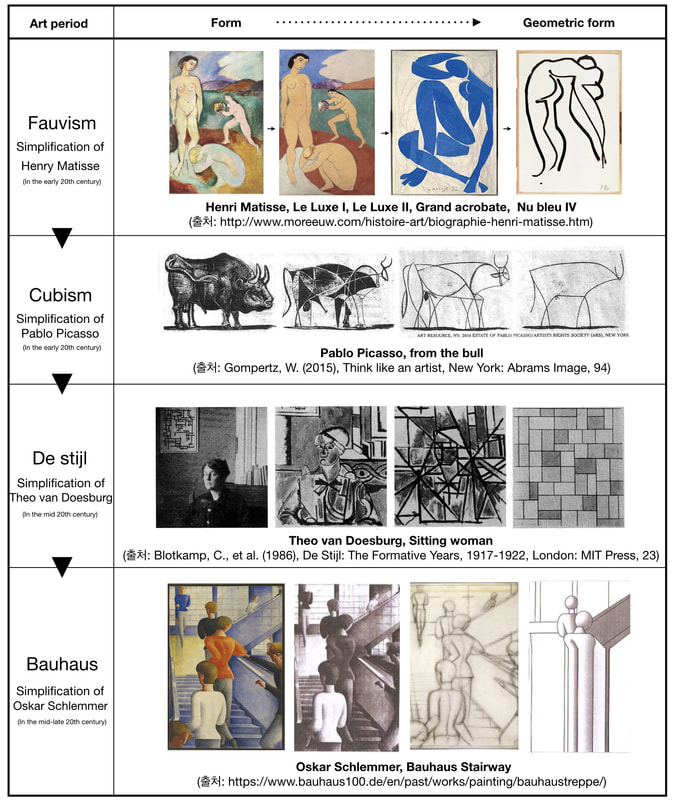Cha, Ha-na
Fashion Design Major, Department of Design and Craft Graduate School of Hong-ik University
Bauhaus, a term which means ‘house construction,’ was a German art school operational from 1919 to 1933 which marked the onset of Modernism with its simplified design and architectural styles using basic forms and primary colours. Furthermore, Bauhaus manifested as a pioneering and innovative approach to modern design and a place to nurture students and professors. This approach then solidified into the rules of its formation and was rooted in the aesthetics of modern design. Walter Gropius (1883-1969) was one of the founders of Bauhaus and intended to gently fuse art with function, form and material in design framed by the philosophical idea that form creation should be fundamental to form training (German: formlehre).
This dissertation is an academic discussion of the theory used in the design and form of pedagogical methods used on the preliminary course at Bauhaus. This study accordingly has two goals: First, to observe the visual grammar used in the preliminary course at Bauhaus which is based on simplifying and distilling a pure form; Second, to analyse the process of simplification of fashion design at Bauhaus and investigate the delineation of fashion through the role of basic formal elements in shape computation and visual grammar. What is essential to this study is analysing the ‘geometric prefiguration’ and ‘theory of formation’ in fashion design. Through this geometric prefiguration and theory of formation, we can witness intrinsic structure and theoretical grammar in the realm of fashion design. On top of this, by attaining a theory of formation in simple design, this research aims to identify an educational method for perceiving the form of fashion design at Bauhaus.
To be specific, the Bauhaus simplification process is analysed according to the educational method of the basic course from three perspectives. First, the Vasili Kandinsky(1866-1944)’s lectures at Bauhaus have been extracted through the ‘theory of points, lines and planes’ which are basic elements in shape grammars. This includes the visual grammar of construction in creation as a principle. Second, based on the theory of design and form by Johannes Itten (1888-1967), the ‘theory of ABC’, which comprises a triangle, a quadrangle and a circle has been analysed. Third, based on Oskar Schlemmer’s (1888-1943) theory of a spatial description, ‘geometrical spatial sculpture’ has been highlighted.
These were found to be essential in investigating the quintessential form of fashion design. The first major finding concerned ‘elimination’ which is the process of distilling decorative elements in fashion design. It is noted that the quintessential form of fashion design in eggshell which was applied through training at Kandinsky’s analytical drawing lecture at Bauhaus. This simplification process in fashion design reveals a veiled figuration of fashion into geometric prefiguration.
The second major finding concerns ‘visual perception of ABC’ which arose from analysis of Itten’s ABC pedagogical theory at Bauhaus. This was the process of observing the form of fashion design through combining and interlocking the elementary figures of a triangle, a quadrangle and a circle. This illuminates the composition of fashion design through basic visual elements and precedes proportion, direction and configuration according to rules of basic formal elements.
The third major finding concerns the ‘solid-geometry’ arising from Schlemmer’s idea of the human figure and spatial formativeness which became laws of form in a lecture at Bauhaus. He revised a homunculus figure and choreographic object within the realm of man in space at Bauhaus. This process is about forecasting the ambiguity of dimensions between the garment and the human figure, which can be the axis to estimate a void. Through these spatial descriptions in fashion, a solid-tectonics in schematics is manifested.
As a matter of fact, the simplification process in fashion design can be witnessed from a pedagogical, creative, aesthetical and productive point of view.
From a pedagogical perspective, the discerned simplification process at Bauhaus is a visual grammar for analysing the basic forms of fashion design. This simplification process can be a form of creative design conception which starts with extremely simplified shapes. In addition, from an aesthetic perspective, the perceived simplification process at Bauhaus inferred geometric shapes in fashion design and can be prefiguration. Lastly, from a productive point of view, this process has potential as a simplified process for mass production.
Accordingly, this study identifies similarities between architecture and fashion in the sense that they force matter to take on perceptual forms. This affinity in the creation of forms follows shape rules and the shape rules follow forms. To observe fashion forms, the theory of Bauhaus taps into the realm of fashion design, merging ideas emerging from Bauhaus simplification using the visual vocabulary from its pedagogical method. This visual training process can be applied in both an elementary and profound theoretical grammar for veiled shape observance in fashion design.


Leave a Reply